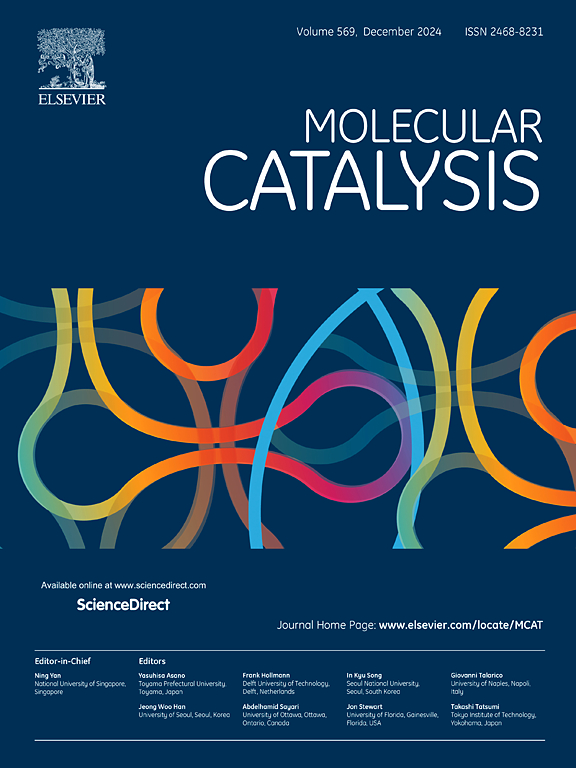Aerobic oxidation of 5-hydroxymethylfurfural to 2,5-furandicarboxylic acid by modification of the crystalline structure of MnO2 for catalytic purposes
IF 3.9
2区 化学
Q2 CHEMISTRY, PHYSICAL
引用次数: 0
Abstract
Investigating the various polymorphs of MnO2 for the catalytic oxidation of 5-hydroxymethylfurfural (HMF) to 2,5-furandicarboxylic acid (FDCA) is motivated by the pressing demand to engineer sustainable and proficient catalytic pathways. These pathways are essential for transforming renewable biomass into valuable chemicals, thereby facilitating the shift towards a circular economy and diminishing our dependence on fossil fuel-derived resources. Herein, three MnO2 catalysts with different crystal structures were prepared for the efficient catalytic oxidation of HMF to FDCA. The results showed that α-MnO2 exhibited higher oxidizing activity per unit specific surface area and an appreciably large specific surface area, however, its overall catalytic activity was found to be less than that of β-MnO2. XRD, SEM, and other characterizations suggest that the presence of smaller nanorods or amorphous particles with reduced crystallinity on the surface of the α-MnO2 catalysts could be responsible for a decreased lattice oxygen content, thereby diminishing their catalytic activity. To validate this conjecture, this paper cites for the first time the application of a dilute nitric acid immersion treatment in the chemical industry to eliminate amorphous structures from catalysts. The α-MnO2-H+ catalyst, prepared using this innovative method demonstrated exceptional activity in facilitating the conversion of HMF to FDCA under more stringent reaction conditions than any monometallic catalysts previously reported. According to the kinetic analysis of the reaction, it was established that the oxidation of 5-formyl-2-furancarboxylic acid (FFCA) to FDCA constitutes the rate-limiting step within the entire oxidation process. On this basis, FT-IR studies showed that the oxidation initiates at the -CHO terminus of HMF, leading to the formation of intermediates 5-hydroxymethylfurfurylacetic acid and 5-formylfurfurylacetic acid within the Mn4+/Mn3+ redox cycle. In conclusion, the enhancement of catalytic activity by diluting nitric acid immersion treatment presents a promising avenue for further research and application in the field of green chemistry.

研究 MnO2 催化 5-hydroxymethylfurfural (HMF) 氧化成 2,5-呋喃二甲酸 (FDCA) 的各种多晶型是出于对设计可持续和熟练催化途径的迫切需求。这些途径对于将可再生生物质转化为有价值的化学品至关重要,从而促进向循环经济的转变,减少对化石燃料衍生资源的依赖。本文制备了三种具有不同晶体结构的 MnO2 催化剂,用于高效催化 HMF 氧化为 FDCA。结果表明,α-MnO2 的单位比表面积氧化活性较高,比表面积也较大,但其整体催化活性低于 β-MnO2。X射线衍射、扫描电镜和其他表征表明,α-MnO2 催化剂表面存在较小的纳米棒或结晶度降低的无定形颗粒,这可能是晶格氧含量降低的原因,从而降低了催化活性。为了验证这一猜想,本文首次引用了化学工业中应用稀硝酸浸泡处理来消除催化剂中的无定形结构。采用这种创新方法制备的 α-MnO2-H+ 催化剂在更严格的反应条件下促进 HMF 向 FDCA 的转化方面表现出了比之前报道的任何单金属催化剂都要出色的活性。根据反应动力学分析,可以确定 5-醛基-2-呋喃甲酸 (FFCA) 氧化成 FDCA 是整个氧化过程中的限速步骤。在此基础上,傅立叶变换红外光谱研究表明,氧化作用始于 HMF 的 -CHO 末端,导致在 Mn4+/Mn3+ 氧化还原循环中形成中间产物 5-hydroxymethylfurfurylacetic acid 和 5-formylfurfurylacetic acid。总之,通过稀硝酸浸泡处理提高催化活性为绿色化学领域的进一步研究和应用提供了一条前景广阔的途径。
本文章由计算机程序翻译,如有差异,请以英文原文为准。
求助全文
约1分钟内获得全文
求助全文
来源期刊

Molecular Catalysis
Chemical Engineering-Process Chemistry and Technology
CiteScore
6.90
自引率
10.90%
发文量
700
审稿时长
40 days
期刊介绍:
Molecular Catalysis publishes full papers that are original, rigorous, and scholarly contributions examining the molecular and atomic aspects of catalytic activation and reaction mechanisms. The fields covered are:
Heterogeneous catalysis including immobilized molecular catalysts
Homogeneous catalysis including organocatalysis, organometallic catalysis and biocatalysis
Photo- and electrochemistry
Theoretical aspects of catalysis analyzed by computational methods
 求助内容:
求助内容: 应助结果提醒方式:
应助结果提醒方式:


